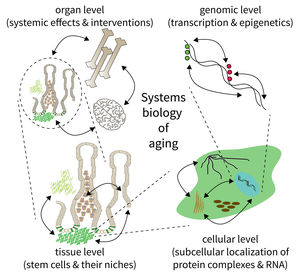Subarea 5: Computational and Systems Biology of Aging
Subarea 5 focuses on the development of methods to analyse and understand complex biological systems. This work includes the design of computer algorithms and biostatistical approaches as well as the development of novel Omic strategies (i.e. genomics/epigenomics, transcriptomics, proteomics, and metabolomics) to study aging and aging-related diseases. According to the FLI, due to the Subarea's expertise in computational data analysis, it is deeply interconnected with all other Subareas. The Subarea hosts two critical core facilities (Life Science Computing, Proteomics) and provides consulting services in statistics. Furthermore, it organizes courses on data analysis and statistics.
The research is defined by five focus areas:
- Mapping extrinsic and intrinsic factors influencing stem cells during aging,
- Integration of spatiotemporal proteomics and transcriptomics data,
- Comprehensive evaluation of qualitative and quantitative expression changes,
- Identification and analysis of epigenomic alterations during aging and age-related diseases, and
- Network analysis of genomic, transcriptomic and epigenomic alterations during aging.
Research focus of Subarea 5.
The biology of aging can be viewed as a multilayered array of networks at the level of organs, cells, molecules, and genes. The FLI wants to meet this complexity by establishing the new Subarea on “Computational and Systems Biology of Aging”. The overall goal is to interconnect research at different scales, taking place in Subareas 1-4 of the Institute’s research program. The new group on Systems Biology will integrate data from networks at multiple scales and will thus point to mechanisms and interactions that would not be seen in unilayer approaches.
Publications
(since 2016)
2020
- Spatially resolved analysis of FFPE tissue proteomes by quantitative mass spectrometry.
Buczak K, Kirkpatrick JM, Truckenmueller F, Santinha D, Ferreira L, Roessler S, Singer S, Beck** M, Ori** A
Nat Protoc 2020, 15(9), 2956-79 ** co-corresponding authors - Pan-cancer analysis of whole genomes.
Campbell PJ, Getz G, Korbel Jea, ICGC/TCGA Pan-Cancer Analysis of Whole Genomes Consortium
Nature 2020, 578(7793), 82-93 - Comprehensive analysis of chromothripsis in 2,658 human cancers using whole-genome sequencing.
Cortés-Ciriano I, Lee JJK, Xi R, Jain D, Jung YL, Yang L, Gordenin D, Klimczak LJ, Zhang CZ, Pellman DS, PCAWG Structural Variation Working Group, Park PJ, PCAWG Consortium
Nat Genet 2020, 52(3), 331 - Loss of metabolic plasticity underlies metformin toxicity in aged Caenorhabditis elegans.
Espada* L, Dakhovnik* A, Chaudhari* P, Martirosyan A, Miek L, Poliezhaieva T, Schaub Y, Nair A, Döring N, Rahnis N, Werz O, Koeberle A, Kirkpatrick J, Ori A, Ermolaeva MA
Nat Metab 2020, 2(11), 1316-31 * equal contribution - Region-specific effects of aging on the small intestinal epithelium and the influence of dietary restriction
Gebert N
Dissertation 2020, Jena, Germany - Region-Specific Proteome Changes of the Intestinal Epithelium during Aging and Dietary Restriction.
Gebert N, Cheng CW, Kirkpatrick JM, Di Fraia D, Yun J, Schädel P, Pace S, Garside GB, Werz O, Rudolph KL, Jasper H, Yilmaz ÖH, Ori A
Cell Rep 2020, 31(4), 107565 - The evolutionary history of 2,658 cancers.
Gerstung M, Jolly C, Leshchiner I, Dentro SC, Gonzalez S, Rosebrock D, Mitchell TJ, Rubanova Y, Anur P, Yu K, Tarabichi M, Deshwar A, Wintersinger J, Kleinheinz K, Vázquez-García I, Haase K, Jerman L, Sengupta S, Macintyre G, Malikic S, Donmez N, Livitz DG, Cmero M, Demeulemeester J, Schumacher S, Fan Y, Yao X, Lee J, Schlesner M, Boutros PC, Bowtell DD, Zhu H, Getz G, Imielinski M, Beroukhim R, Sahinalp SC, Ji Y, Peifer M, Markowetz F, Mustonen V, Yuan K, Wang W, Morris QD, PCAWG Evolution and Heterogeneity Working Group, Spellman PT, Wedge DC, Van Loo P, PCAWG Consortium
Nature 2020, 578(7793), 122-8 - Dichotomous Impact of Myc on rRNA Gene Activation and Silencing in B Cell Lymphomagenesis.
Joshi* G, Eberhardt* AO, Lange L, Winkler R, Hoffmann S, Kosan C, Bierhoff H
Cancers (Basel) 2020, 12(10), E3009. doi: 10.3390/cancers12103 * equal contribution - Reduced proteasome activity in the aging brain results in ribosome stoichiometry loss and aggregation.
Kelmer Sacramento* E, Kirkpatrick* JM, Mazzetto* M, Baumgart M, Bartolome A, Di Sanzo S, Caterino C, Sanguanini M, Papaevgeniou N, Lefaki M, Childs D, Bagnoli S, Terzibasi Tozzini E, Di Fraia D, Romanov N, Sudmant PH, Huber W, Chondrogianni N, Vendruscolo M, Cellerino** A, Ori** A
Mol Syst Biol 2020, 16(6), e9596 * equal contribution, ** co-corresponding authors - Bashing irreproducibility with shournal
Kirchner T, Riege K, Hoffmann S
bioRxiv 2020, https://doi.org/10.1101/2020.08.









